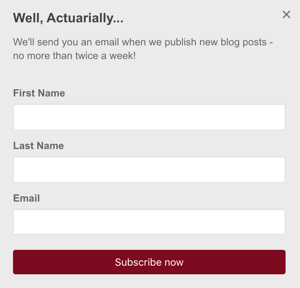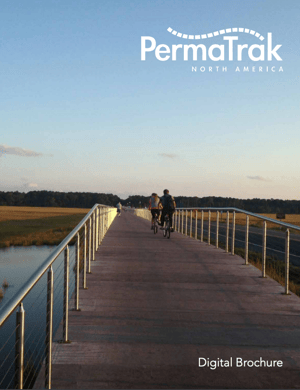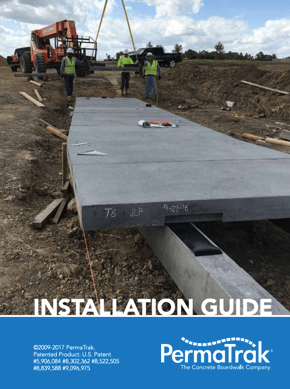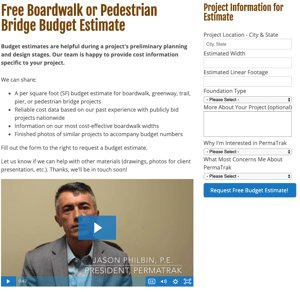Your project photos and technical information could use some updating. But for the most part, your website does what you need it to do: it provides a way for your potential clients to check out your products and get in touch when they’re ready. Does this sound familiar?
Meanwhile, your sales team works tirelessly each day reaching out to potential clients, putting quotes together, attending the “necessary evil” trade shows, following up on projects that have stalled, and closing deals. Is your website working to help your sales team?
Many B2B companies would say yes, the website is there to provide information and the sales team can help supplement that information when a lead is ready to talk to a sales rep about their project. But if your website only offers one opportunity for a visitor to provide their information on your “Contact Us” page, you’re limiting your website’s lead generation capability to the 1-2% of people who are sales qualified, or ready to speak to sales.
Most of Your Website Visitors Aren’t Ready to Hit “Contact Us” - Love Them Just the Same
It's important to show some love to the people visiting your site who aren't 100% sure they want to use your product (keep in mind, this is 98-99% of your website visitors). You can still provide value to this group with a content strategy that helps move them through the sales funnel. This will also help you keep track of and reach out to other prospects.
Evaluate your website and see where there is opportunity for improved interactions with this type of visitor by answering the following questions:
1. Does my website have web pages, articles, infographics, and/or videos that answer our prospects’ most common questions?
Think of this content as ammo for your sales team to use in follow up touches. The more content available for your prospect to read about your company and its products, the more they will come back to your website and engage with your materials, and the higher qualified of a lead they become.
2. Does my website convey credibility, transparency and trust?
Compare it to your competitors' sites, and remember the true cliche: People buy from people they know, like and trust.
3. Does my website offer opportunities to convert the 98-99% of visitors who aren’t yet ready to get in touch with us?
This is where most companies in our industry fall short. The vast majority of their website visitors come to the site as strangers, browse around, then leave the site. We have no idea who they are or why they came in the first place. Big time opportunity lives here - what can you offer people who are in the bucket of “Hey I’m not quite ready to talk to a salesperson, but I want some more information?”
These types of visitors are sometimes referred to as “information qualified” or “top of the funnel” leads. What you call them doesn’t matter; what matters is the fact that you’re now capturing more of your website visitors into your marketing funnel. Now you can present an intuitive path for them to follow, continue to educate them, help them do their research and find the best fit product for their needs.
By building relevant content, conveying credibility and offering premium content, your website will allow you to convert visitors through “transitional” offers outside of the Contact Us form. Some examples include:
- A free color sample packet mailed to them
- A free literature brochure download
- 10-step buyer’s guide
The video below shares examples of what these different offers can look like.
Let’s talk about the different stages of the sales funnel that prospects may visit your site, and how to use forms to help capture their information and turn them into leads.
Awareness/Education Stage
When John (or Jane) Doe visits your site for the first time, they’re probably only looking for information to learn more about your product or services. What are the chances they’ll fill out your “Contact Us” form? Slim to none.
 However, if you ask people to provide their email address to subscribe to your newsletter, explaining who the newsletter is for and the value they’ll get out of reading it once every week/month, you’re more likely to get contact information for people who are at least somewhat interested in learning more about your business.
However, if you ask people to provide their email address to subscribe to your newsletter, explaining who the newsletter is for and the value they’ll get out of reading it once every week/month, you’re more likely to get contact information for people who are at least somewhat interested in learning more about your business.
To the right, you'll see an example from one of our clients, Wakely Actuarial. This sign-up form appears on their homepage, asking visitors to sign up for notifications about new blog posts. So far, nearly 2% of their visitors have signed up, providing valuable contact information that their sales team can use to follow up.
Consideration Stage
As your visitors learn more about your product and the problems you can solve, they’ll start to look at different options and move further down the path of deciding which is best for them. Think they’re ready for the “Contact Us” form now? Not so fast!


Create a short ebook (PDF file) that lays out the features and benefits of your products, put together a presentation that can be downloaded to share with colleagues, or give them the ability to request a sample packet of your product colors. In exchange, visitors should provide their name, email, phone number, and company name. Just be sure that the information you request seems like a fair trade for the information your visitors are getting. They need to see value in what you’re offering if they’re going to share contact information with you.
Decision Stage
Once your visitors have learned how awesome your product is and they’re ready to make a decision, they’re more likely to fill out the “Contact Us” form, but there are other options for you to try.
 A unique way to position an offer in this Decision stage would be as a free technical consultation with one of your subject matter experts. This is a nicer way of saying, “Get on the phone with a sales rep.” You could also position a free budget estimate here. At this point, you should ask the visitor to fill out more fields than they would in the Awareness or Consideration stage. This may include things like Job Title, information about their project, their biggest challenge, etc. If you need more information, make sure your sales team gathers that info during their initial sales call.
A unique way to position an offer in this Decision stage would be as a free technical consultation with one of your subject matter experts. This is a nicer way of saying, “Get on the phone with a sales rep.” You could also position a free budget estimate here. At this point, you should ask the visitor to fill out more fields than they would in the Awareness or Consideration stage. This may include things like Job Title, information about their project, their biggest challenge, etc. If you need more information, make sure your sales team gathers that info during their initial sales call.
A Lead Generation Opportunity You Shouldn’t Ignore
Building in short contact forms on your website is a best practice all commercial product suppliers should include as part of their marketing strategy. This is an exceptionally important addition to your website as capturing this visitor’s information can help build your customer database and increase lead generation. You can use this information to reach out to them later via email, phone, or newsletter. The idea is if they’re visiting your website, they’re likely interested in your products or services, so don’t miss this vital opportunity to capture this lead’s information.
Improving your website by building out a strong content strategy, conveying trust and also having opportunities for prospects at the top of the sales funnel to learn more through non-Contact Us forms and offers can go a long way.
Not sure how to get started? Not a problem. Reach out to us and talk with a marketing strategist about your business (see how we’re assuming you’re ready to talk at this stage?) We’ll spend 15 minutes getting to know your marketing and sales models, then offering insight on strategy and content that has worked with our clients in this industry.
